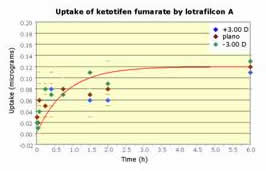Uptake of anti-allergenic drugs by silicone hydrogel lens materials
Direct and indirect interactions between soft contact lenses and topical ocular medicaton have the potential to cause or contribute to dry eyes and irritation, and may ultimately contribute to chronic eye infection. Absorption of medication by contact lens materials during contact lens wear can lead to prolonged contact times or gradual release of the medication from the lens material once treatment has ceased. Moreover, compromise of the ocular surfaces during lens wear may provide an avenue for greater absorption of the medication by ocular tissue. Unnecessary complications can be avoided by better understanding the basis of how contact lens materials interact with ocular medication.
Anti-inflammatory agents such as ketotifen fumarate and sodium cromoglycate are recommended treatment for seasonal allergic conjunctivitis. However, because of the potential for hypersensitivity reactions arising from the interaction between active ingredients of these drugs and soft contact lens materials, it is advised that patients discontinue lens wear until treatment has ceased.
An in vitro study was devised to examine the level of uptake of these drugs by a silicone hydrogel contact lens (lotrafilcon A). The active agents of each drug were dissolved in isotonic saline solution at therapeutic concentrations. Silicone hydrogel contact lenses of different powers (+3,00 D, plano and -3,00 D) were inserted into each drug solution for calculated time intervals (1, 5, 15, 45, 90, 120 and 360 minutes) and the UV/VIS absorption spectra of each solution was determined before lenses were inserted and after each time interval. The difference between these corresponded to the absorption of the active agents diffused into the contact lens.
Little to no sodium cromoglycate was detected; there were no differences between lens powers and no changes over time (see Figure 1). Although ketotifen fumarate was detected, the levels remained low for the time studied; absorption increased over the first 45 minutes and plateaued thereafter (see Figure 2). There were no differences in the level of absorption of ketotifen fumarate between lens powers.
 |
| Figure 1 - click to enlarge |
 |
| Figure 2 - click to enlarge |
Conclusion
This preliminary in vitro study demonstrates that lotrafilcon A did not absorb either sodium cromoglycate or ketotifen fumarate at therapeutically relevant concentrations and therefore it may not be necessary to cease lens wear when being treated topically with these drugs.
Practitioners need to be aware of the interactions between soft contact lenses and ocular medication when advising their patients. In vivo studies examining the uptake of anti-allergenic drugs during silicone hydrogel lens wear will provide further information on the interaction of these drugs and silicone hydrogel contact lens materials.
|